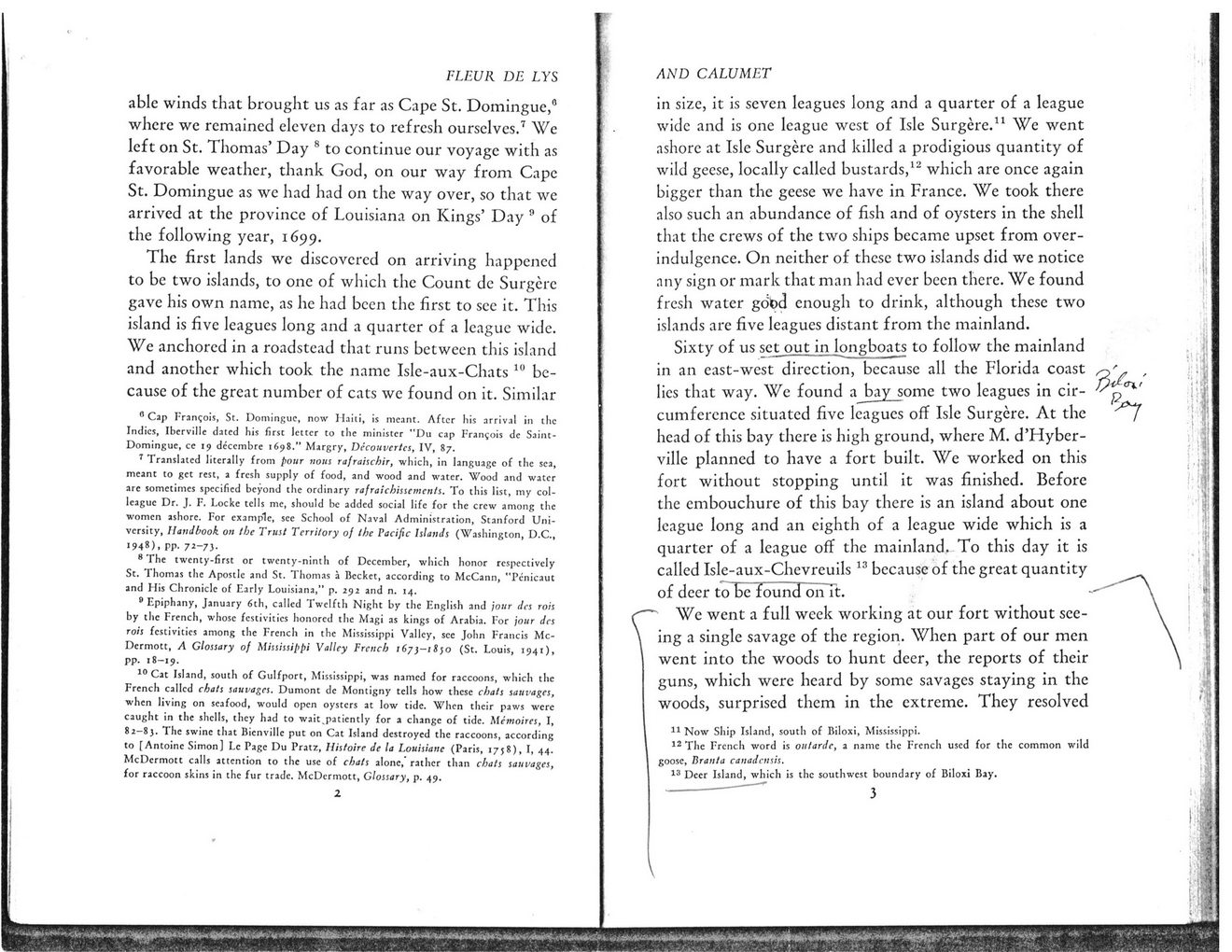This text was obtained via automated optical character recognition.
It has not been edited and may therefore contain several errors.
FLEUR DE LYS able winds that brought us as far as Cape St. Domingue,0 where we remained eleven days to refresh ourselves.7 We left on St. Thomas’ Day 8 to continue our voyage with as favorable weather, thank God, on our way from Cape St. Domingue as we had had on the way over, so that we arrived at the province of Louisiana on Kings’ Day 9 of the following year, 1699. The first lands we discovered on arriving happened to be two islands, to one of which the Count de Surgere gave his own name, as he had been the first to see it. This island is five leagues long and a quarter of a league wide. We anchored in a roadstead that runs between this island and another which took the name Isle-aux-Chats 10 because of the great number of cats we found on it. Similar 0 Cap Francois, St. Domingue, now Haiti, is meant. After his arrival in the Indies, Iberville dated his first letter to the minister "Du cap Francois de Saint-Domingue, cc 19 deccmbre 1698.” Margry, Decouvertes, IV, 87. 7 Translated literally from pour nous rafraischir, which, in language of the sea, meant to get rest, a fresh supply of food, and wood and water. Wood and water are sometimes specified beyond the ordinary rafraichissements. To this list, my colleague Dr. J. F. Locke tells me, should be added social life for the crew among the women ashore. For example, see School of Naval Administration, Stanford University, Handbook on the Trust Territory of the Pacific Islands (Washington, D.C., 1948), PP- 72-73- 8 The twenty-first or twenty-ninth of December, which honor respectively St. Thomas the Apostle and St. Thomas a Becket, according to McCann, "Pcnicaut and His Chronicle of Early Louisiana,” p. 292 and n. 14. 9 Epiphany, January 6th, callcd Twelfth Night by the English and jour des rois by the French, whose festivities honored the Magi as kings of Arabia. For jour des rois festivities among the French in the Mississippi Valley, see John Francis McDermott, A Glossary of Mississippi Valley French 1673-/850 (St. Louis, 1941), pp. 18-19. 10 Cat Island, south of Gulfport, Mississippi, was named for raccoons, which the French callcd chats sauvages. Dumont de Montigny tells how these chats sauvages, when living on seafood, would open oysters at low tide. When their paws were caught in the shells, they had to wait patiently for a change of tide. Mentoires, I, 82-83. The swine that Bienville put on Cat Island destroyed the raccoons, according to [Antoine Simon] Lc Page Du Pratz, Iiistoire de la Louisiane (Paris, 1758), I, 44. McDermott calls attention to the use of chats alone, rather than chats sauvages, for raccoon skins in the fur trade. McDermott, Glossary, p. 49. 2 AND CALUMET in size, it is seven leagues long and a quarter of a league wide and is one league west of Isle Surgere.11 We went ashore at Isle Surgere and killed a prodigious quantity of wild geese, locally called bustards,12 which are once again bigger than the geese we have in France. We took there also such an abundance of fish and of oysters in the shell that the crews of the two ships became upset from over-indulgence. On neither of these two islands did we notice any sign or mark that man had ever been there. We found fresh water gobd enough to drink, although these two islands are five leagues distant from the mainland. Sixty of us set out in longboats to follow the mainland in an east-west direction, because all the Florida coast lies that way. We found a bay some two leagues in circumference situated five leagues off Isle Surgere. At the head of this bay there is high ground, where M. d’Hyberville planned to have a fort built. We worked on this fort without stopping until it was finished. Before the embouchure of this bay there is an island about one league long and an eighth of a league wide which is a quarter of a league off the mainland. To this day it is callcd Isle-aux-Chevreuils 13 because of the great quantity of deer to be found on it. (We went a full week working at our fort without see-\ ing a single savage of the region. When part of our men went into the woods to hunt deer, the reports of their guns, which were heard by some savages staying in the woods, surprised them in the extreme. They resolved I 11 Now Ship Island, south of Biloxi, Mississippi. 1 12 The Frcnch word is outardci a name the Frcnch used for the common wild I goose, Bratt/a canadcmii. 13 Deer Island, which is the southwest boundary of Biloxi Bay. ----------------- 3

Penicaut Narrative Document (014)